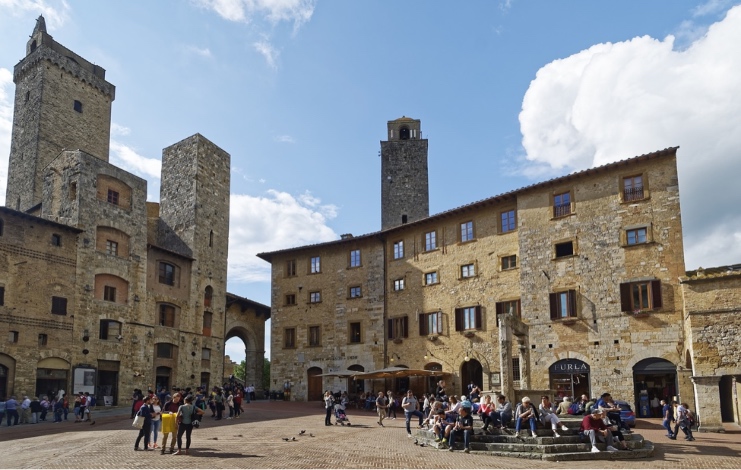Planning a Tuscany vacation? Chances are your itinerary includes stops or stays in Tuscany’s big cities and major attractions of Siena, Florence, and Pisa. However, these predictable tourist destinations can prevent you from seeing the smaller towns and more remote villas in Tuscany that make the region such a compelling destination.
The following are some of the towns you should consider taking a look at when you make your way to Tuscany.
San Gimignano
The Seven Hills of Rome may be more famous but the 15 towers of San Gimignano are equally breathtaking. Penetrating the Tuscany sky and just an hour’s drive from Siena, this undulating commune was first clad in slate and stone cottages by ancient Etruscans.
After the fall of Rome, the Church improved on this foundation by building the Collegiate Church of Santa Maria Assunta and the Sant’Agostino Basilica. Even those centuries ago, the stream of poets and pilgrims eulogized the town’s majestic beauty that was complemented by the rolling groves of cypress.
Lucca
Tucked between Pisa and the Tyrrhenian Sea coast, the town of Lucca seemingly clings to the Serchio River basin lowlands. It’s surrounded by impressively preserved Renaissance bulwarks that are now covered by moss, eucalyptus trees, and cypresses. It’s a walk-friendly town whose center is dominated by the Piazza dell’Anfiteatro.
When you visit, the Lucca Cathedral is one whose splendor you are unlikely to forget.
Cortona
Sitting on the hillsides along the eastern edge of Tuscany, Cortona is a gorgeous, stone-clad town that marks its place through an enchanting medieval tower. The winding alleys feature swinging clothes lines amidst hanging baskets of blooming rose flowers and sage.
Thanks to its location above the rolling Valdichiana plains below, its flagstone-cloaked piazzas provide one of the best panoramas of central Italy. You can even see the waters of the Lake Trasimeno glittering like a precious stone in the distance. Cortona’s marketplaces come alive over the weekends running all the way from the Santa Maria Cathedral to Garibaldi Square.
Montepulciano
Montepulciano is famed for the full-bodied, eponymous red grapes that are at the heart of the town’s seemingly endless stretches of vineyards. But the town has a rustic beauty that has proved to be a magnet for visitors. Thousands of visitors make their way to this terracotta and red-brick municipality each year.
The tight meshwork of lanes weaves their way from the town’s fringes to its center where the travertine and marble masterpieces of the Piazza Grande mesmerize the senses. You’ll encounter the Palazzo Nobili-Tarugi and the Palazzo Comunale here with their shadowy archways and chiseled columns. The tiled slanting roofs nearby seem to cascade all the way to the cypress and pine woodlands below.
Montepulciano’s ancient streets exude Roman influence and Etruscan history.
Suvereto
Sitting just a couple of kilometers from the waves of the Mediterranean Sea, Suvereto has earned its reputation as one of Italy’s best small towns. It’s nestled between the forests of Livorno that roll west toward the hills of Campiglia Marittima and east heading to the Marsiliana Reserve.
Stone buildings rule its center culminating in a Renaissance castle that’s covered in lichen and creeping vines. The Via Matteotti is arguably the heartbeat of the town and is packed with fascinating porticos, cellar doors, and slow food gourmet joints.
Fosdinovo
Lining the tops of Carrara and Massa hillsides, the town of Fosdinovo looks like a hue of terracotta and brownstone when juxtaposed against the olive and fir forests of the Apuan Alps. At its center is the formidable and mighty Malaspina Castle that has characterized the town’s skyline for more than 800 years.
On the horizon, you can see where the Tyrrhenian Sea signals the edge of Tuscany. Fosdinovo is the quintessential simultaneously charming and dramatic Italian town.
Pitigliano
A phalanx of brick and stone rising sharply between Lazio and Tuscany, Pitigliano is the kind of town that would be perfect for postcards and travel brochures. Its height looks like an organic extension to the rock bowls underneath. First carved by the Etruscans, it was polished by the Romans before being perfected by the ostentatious wealth of the Orsini dynasty.
At its center, weaving cobblestone streets plunge beneath archways, bougainvillea cascades swoop overhead, shadowy stairs guide you to inviting synagogues and cultural festivals enliven the Piazza Garibaldi.



